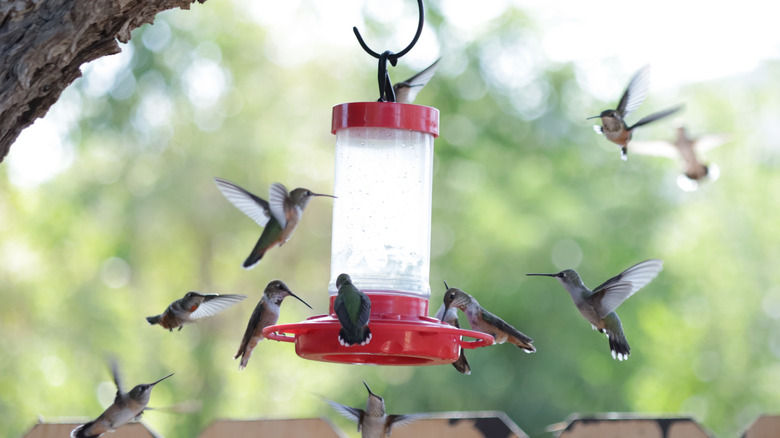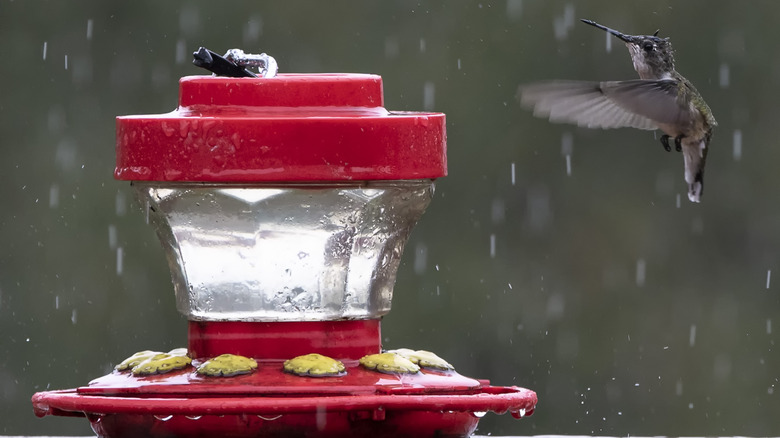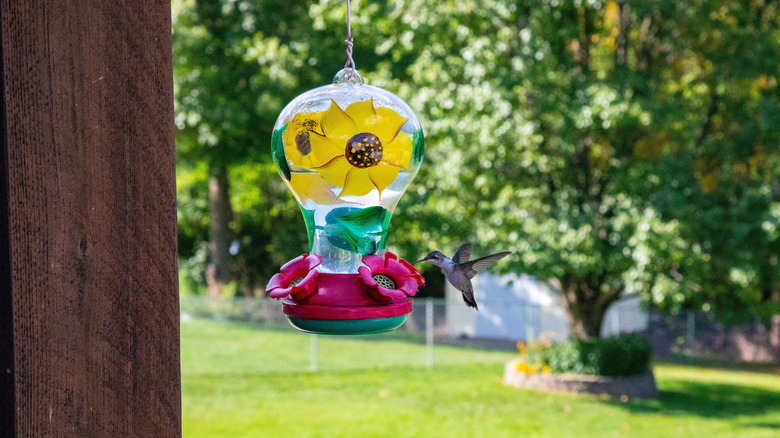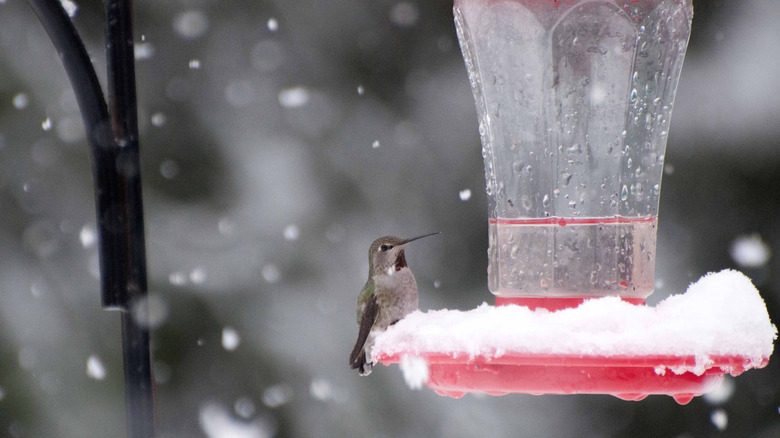How Weather Affects Hummingbird Feeders And Essential Tips You Should Know
Anyone lucky enough to live somewhere frequented by hummingbirds knows how exciting it is to see one of these vibrant little creatures fluttering around the garden. Fortunately, if you live in a hummingbird habitat but never seem to spy them, it's incredibly easy to attract them to your property with a feeder. You don't even have to spend a fortune — there are many ways to make a simple DIY hummingbird feeder. Making hummingbird nectar is also straightforward, as all you have to do is combine one part sugar with four parts water. However, your hummingbird housewarming gift can quickly go to waste if you don't consider how different weather conditions affect a feeder. Extreme rain, heat, and cold can all negatively impact hummingbird feeders.
Hummingbird feeders should be refilled regularly, but generally speaking, feeders that face a lot of heavy rain or intense heat need to be replaced even more frequently so the nectar doesn't go bad. On the other hand, hummingbird nectar kept in the cold won't spoil, but it can become impossible for the birds to access. Any of these issues can cause hummingbirds to stop visiting your home, so to make your feeders as inviting as possible, it's important to account for the effects of bad weather.
Rain can ruin hummingbird nectar
Despite their diminutive size (or perhaps because of it), hummingbirds have no issue navigating through wind and storms, but high levels of rainfall can affect their food sources, particularly nectar-filled feeders. That's because if too much water gets into a feeder due to heavy rain, it can dilute the nectar. Hummingbirds are rather picky, and you'll need a solution with a pretty exact ratio in order to attract them. If you have a smaller hummingbird feeder (about 12 ounces or less), even just an ounce or two of rainwater can throw that ratio off. Nectar with too much water won't be sugary enough for hummingbirds, and they'll ignore your feeder in favor of sweeter fare.
This issue is most common with bowl-style hummingbird feeders since the feeding ports are directly exposed to the elements. It takes more than a light sprinkle to dilute hummingbird nectar, so this usually isn't an issue for drier climates. But if you live in a rainy area and wonder why hummingbirds aren't visiting your yard, it's worth moving the feeders to a covered area and checking them to ensure they aren't taking on excess water.
Aside from throwing off the sugar concoction, extreme weather conditions can knock hummingbird feeders off their hooks. That's why not setting up securely is one of many errors you don't want to make with hummingbird feeders.
Heat can be horrible for feeders
Along with protecting them from precipitation, moving your hummingbird feeders to give them more shelter from the elements will also help slow down the harmful effects of too much sun or heat. When the sugar water is too hot for too long, there's a high chance it will ferment and start to develop mold. This can make the nectar harmful or even deadly to hummingbirds. You can identify hummingbird nectar that has gone bad by its murky appearance, but even if the solution looks clear, it should be replaced regularly to keep birds flocking to your feeders healthy.
Exactly how often you should change out hummingbird nectar to keep it fresh depends on how hot it is. Feeders subject to temperatures between 90 and 100 degrees Fahrenheit need to be cleaned and refreshed every day; once the temperature reaches 100 degrees, the frequency goes up to thrice a day.
It's not enough to just refill the feeders with fresh nectar. You will also need to safely clean your hummingbird feeders with soap and hot water. To make caring for hummingbirds a little easier during hot months, you may want to keep multiple feeders on hand so you can always have a clean one ready to go. Other ways to potentially slow the growth of mold and bacteria in the feeders include keeping them out of direct sunlight and avoiding plastic feeders.
Cold nights can freeze sugar water
Even though hummingbirds usually migrate during the early fall, it's becoming less uncommon to spot them during the winter season, especially for folks along the United States' west and southern coasts. As nice as it is to see colorful hummingbirds during the dreariest months of the year, this also means that you may need to weatherproof your feeders to protect them from the cold. Since hummingbird nectar is mostly water, it has the potential to freeze as soon as the thermometer drops below 32 degrees Fahrenheit. This renders the feeders unusable by hummingbirds and can even damage them if the frozen nectar expands and cracks the reservoir.
Hummingbird enthusiasts have a few different techniques to keep feeders from freezing. For example, electric heat sources like heat lamps, heating pads, and even Christmas lights can emit enough warmth to maintain liquid nectar. Alternatively, it's possible to insulate the nectar holder by wrapping it in warm fabric.
When the weather is cold, it's a good idea to bring hummingbird feeders inside at night so they aren't exposed to even chillier temperatures. Hummingbirds stop eating once the sun goes down, so it's advised you always take down the feeders at night so they are not exposed to the elements unnecessarily. If you live somewhere with lots of wildlife, keeping hummingbird feeders inside after sunset also decreases the likelihood that they'll be burgled or vandalized by some other critter.



